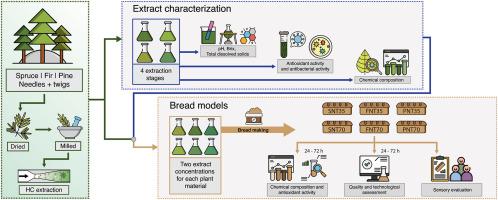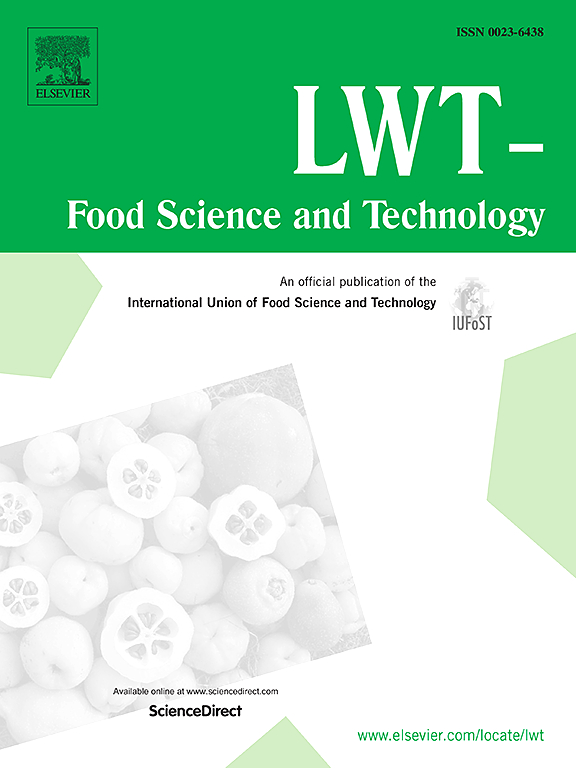云杉、松树和冷杉针叶作为全麦面包强化剂的可持续配料:增强营养和功能特性
IF 6
1区 农林科学
Q1 FOOD SCIENCE & TECHNOLOGY
引用次数: 0
摘要
本研究调查了云杉、松树和冷杉的绿针叶和细枝(NT),这些广泛存在的森林副产品是全麦面包强化的潜在功能成分和天然防腐剂。我们评估了以 0%、35% 和 70% 的 NT 提取物代替水对面包的次生代谢物分析、生物活性、营养和质量的影响。经过 24 小时和 72 小时的 HPLC-DAD 分析,NT 面包中的化合物表现出良好的稳定性。这种增加与贮藏期间抗氧化活性提高了 80% 以上密切相关,表明贮藏期延长了。通过超高效液相色谱-QTOF-MS/MS,共鉴定出 115 种化合物,包括黄酮类、酚酸类、生物碱类、二苯乙烯类、木脂素类、树脂酸类和赤霉素类。在各种替代水平中,35% 的替代水平(尤其是松树 NT 强化面包)足以在保持面包质量和感官可接受性的同时增强其功能性,使其成为进一步开发生物活性产品的有力候选。总之,研究结果证明了未充分利用的有色金属作为天然抗氧化剂的价值潜力,并将有助于为业界提供植物化学成分信息。本研究通过采用绿色萃取技术(流体动力空化),强调了这些侧流更广泛的适用性,该技术可产生有价值的化合物,促进可持续发展,并通过具有成本效益的高效工艺支持循环经济。本文章由计算机程序翻译,如有差异,请以英文原文为准。

Spruce, pine and fir needles as sustainable ingredients for whole wheat bread fortification: Enhancing nutritional and functional properties
This study investigated green needles and fine twigs (NT) from spruce, pine, and fir, widely available forest by-products, as potential functional ingredients and natural preservatives for whole wheat bread fortification. The effects of replacing water with NT extracts at 0, 35, and 70% levels were assessed on bread's secondary metabolite profiling, bioactivity, nutrition, and quality. The NT-bread demonstrated good stability of compounds analyzed by HPLC-DAD after 24 and 72 h, with a notable increase in the content of several polyphenols after 72 h of storage. This increase was correlated closely with an over 80% enhancement in antioxidant activity during storage, suggesting extended shelf-life. A total of 115 compounds were identified by UHPLC-QTOF-MS/MS, including flavonoids, phenolic acids, alkaloids, stilbenes, lignans, resin acids, and gibberellins. Among the substitution levels, 35% , particularly pine NT-fortified bread, was sufficient to enhance functionality while preserving bread quality and sensory acceptability, making it a strong candidate for further development as a bioactive product. Overall, the findings demonstrate the valorization potential of underutilized NT as natural antioxidants and will help provide the industry with phytochemical compositional information. This study highlights the broader applicability of these side streams by employing a green extraction technique (hydrodynamic cavitation) that yields valuable compounds, promotes sustainability, and supports the circular economy through a cost-effective and efficient process.
求助全文
通过发布文献求助,成功后即可免费获取论文全文。
去求助
来源期刊

LWT - Food Science and Technology
工程技术-食品科技
CiteScore
11.80
自引率
6.70%
发文量
1724
审稿时长
65 days
期刊介绍:
LWT - Food Science and Technology is an international journal that publishes innovative papers in the fields of food chemistry, biochemistry, microbiology, technology and nutrition. The work described should be innovative either in the approach or in the methods used. The significance of the results either for the science community or for the food industry must also be specified. Contributions written in English are welcomed in the form of review articles, short reviews, research papers, and research notes. Papers featuring animal trials and cell cultures are outside the scope of the journal and will not be considered for publication.
 求助内容:
求助内容: 应助结果提醒方式:
应助结果提醒方式:


